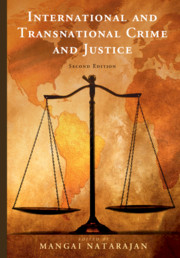Book contents
- International and Transnational Crime and Justice
- International and Transnational Crime and Justice
- Copyright page
- Contents
- Figures and Tables
- Preface
- About the Editor
- Notes on Contributors
- Introduction
- PART I OVERVIEW: TRANSNATIONAL CRIME
- PART IA Varieties of Transnational Crimes
- PART IB Transnational Organized Crime
- 27 TRANSNATIONAL ORGANIZED CRIME
- 28 Transnational Crime Patterns and Trends
- 29 Transnational Organized Crime Networks
- 30 Italian Organized Crime
- 31 Extortion and Organized Crime
- 32 Russian Organized Crime
- 33 The Rise of Balkan Organized Crime
- 34 Organized Crime Groups in Asia Hong Kong and Japan
- 35 Drug Cartels Neither Holy, Nor Roman, Nor an Empire
- 36 Probing the “Nexus” between Organized Crime and Terrorism
- PART IC Factors that Facilitate Transnational Crimes
- PART ID Transnational Justice Matters
- PART II OVERVIEW: INTERNATIONAL CRIME
- PART III OVERVIEW: INTERNATIONAL AND TRANSNATIONAL CRIME RESEARCH
- World Map
- Index
- References
29 - Transnational Organized Crime Networks
from PART IB - Transnational Organized Crime
Published online by Cambridge University Press: 20 June 2019
- International and Transnational Crime and Justice
- International and Transnational Crime and Justice
- Copyright page
- Contents
- Figures and Tables
- Preface
- About the Editor
- Notes on Contributors
- Introduction
- PART I OVERVIEW: TRANSNATIONAL CRIME
- PART IA Varieties of Transnational Crimes
- PART IB Transnational Organized Crime
- 27 TRANSNATIONAL ORGANIZED CRIME
- 28 Transnational Crime Patterns and Trends
- 29 Transnational Organized Crime Networks
- 30 Italian Organized Crime
- 31 Extortion and Organized Crime
- 32 Russian Organized Crime
- 33 The Rise of Balkan Organized Crime
- 34 Organized Crime Groups in Asia Hong Kong and Japan
- 35 Drug Cartels Neither Holy, Nor Roman, Nor an Empire
- 36 Probing the “Nexus” between Organized Crime and Terrorism
- PART IC Factors that Facilitate Transnational Crimes
- PART ID Transnational Justice Matters
- PART II OVERVIEW: INTERNATIONAL CRIME
- PART III OVERVIEW: INTERNATIONAL AND TRANSNATIONAL CRIME RESEARCH
- World Map
- Index
- References
- Type
- Chapter
- Information
- International and Transnational Crime and Justice , pp. 175 - 180Publisher: Cambridge University PressPrint publication year: 2019
References
REFERENCES
- 2
- Cited by



